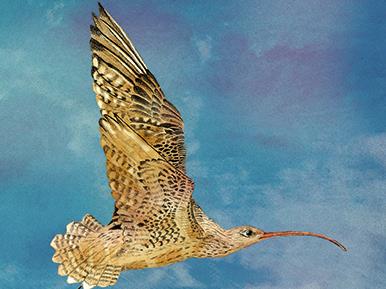Harry Saddler’s The Eastern Curlew. Published by Affirm Press.
Harry Saddler writes with such contagious enthusiasm that it is impossible not to share his love of birds. He has singled out the eastern curlew as the subject of his book because it is an incredible bird with astonishing abilities that is also in danger of extinction.
The word-picture Saddler paints of this bird is so vivid that the book needs no illustrations and, except for the book’s cover, it has none. As birds go, the eastern curlew is large and weighs in at about one kilogram, that is, before it flies about 10,000 kilometres from Australia to Siberia each autumn, losing much of its body weight in the process. Having bred and fed in the arctic summer, when autumn comes to the northern hemisphere, the curlew flies the 10,000 kilometres back to Australia.
No wonder Saddler wants us to share his love, his respect and his admiration for this wonderful creature. He does that in a number of ways.
One such way is the provision of some engaging historical detail about the eastern curlew. Saddler recounts some of the early recorded sightings of it and refers to several beautiful illustrations of the bird, not least the ‘stunning’ one in the famous publication, The Birds of Australia by John Gould. We learn that the eastern curlew’s scientific name of numenius madagascariensis came about as a mistake as no eastern curlew has been seen anywhere near Madagascar, but he concedes that numenius, which means ‘new moon’, ‘derives from the slender curve of a curlew’s bill’, a bill ideal for digging up small mud crabs hiding below the surface in mud flats.
Another method Saddler deploys to whet our interest is autobiographical. He describes his youthful interest in all animals but particularly in birds. He takes us with him on many an excursion to look at birds in their natural habitat. He shares his thoughts and speculations with us. He has the energy and persistence to walk long distances and wait for hours for the chance to catch a glimpse of the eastern curlew and he also describes many other birds he sees. His stamina seems unbounded and his writing is such that you begin to think of him as a companion with whom you go bird-watching.
Finally, Saddler takes us to some of the places along the route of the ‘East Asian-Australasian Flyway’. Apparently, migrating birds use certain established routes specific to each species. These are called ‘flyways’, and in the case of the eastern curlew the flyway from Australia soars over 22 countries including South Korea, China and Finland. Saddler’s accounts of his visits to these places, what he sees and whom he meets make fascinating reading. It is a pity that no flyway maps are included, though perhaps that is because they can be found so easily on the internet.
Unfortunately, the eastern curlew is a highly endangered species. Saddler describes in some detail the mud flats that are their feeding grounds and which are therefore essential for the birds’ survival. Regrettably, many of these mud flats have been ‘reclaimed’ for commercial purposes. He fears, with some justification, that the eastern curlew will soon become extinct as a result of human activity.
This book can be read for sheer enjoyment of the writing; it can be read to broaden one’s knowledge of some of the wonderful creatures with which we share this planet; but above all, it is a challenge to all of us to help conserve what millions of years of evolution has produced and which can be irreparably destroyed so easily. The result is a convincing and heartfelt plea to protect the eastern curlew from extinction.
Rating: 4 ½ stars ★★★★☆The Eastern Curlew
By Harry Saddler
Published by Affirm Press
ISBN: 9781925584219
Hardback
180 x 130 mm
Nature/Natural History





